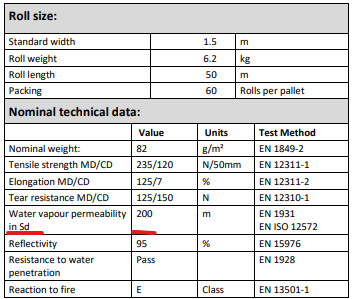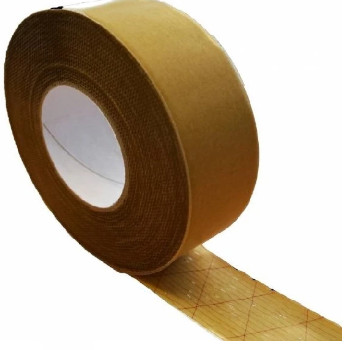
VAPOUR CONTROL LAYER. THE UGLY TRUTH?*
Vapour damage is a serious problem you don’t want to deal with. The problem of water vapour affects not only old buildings that were erected according to outdated standards. New constructions are also full of shortcomings. So there is a high probability that in our house the degree of water vapour removal is also insufficient. This increases the risk that moisture will simply settle on the structural elements. Protection against this phenomenon should be ensured by the proper arrangement of materials.
By introducing a vapour control layer, you can protect yourself from the cost associated with condensation. We understand mitigating the risk of condensation can be a demanding task, that is why we decided to share with you all the information gained over years.
In this article, we will try to bring some clarity to the vapour control layer and use of internal foils to help you decide which type to use, where and how. We will reveal to you both the good and bad sides of the foil.
 TABLE OF CONTENTS
TABLE OF CONTENTS
- VAPOUR CONTROL LAYER. THE UGLY TRUTH?
- WHAT IS A VAPOUR CONTROL LAYER?
- WHERE DO I PUT THE VAPOUR CONTROL LAYER?
- WHEN DO I NEED A VAPOUR CONTROL LAYER?
- VAPOUR CONTROL LAYER SD VALUE. WHY IS IT SO IMPORTANT?
- WHAT IS Sd VALUE?
- HOW TO UNDERSTAND THE Sd VALUE?
- WHAT WILL HAPPEN IF I CHOOSE WRONG VAPOUR CONTROL LAYER?
- TYPES OF VAPOUR CONTROL LAYER ǀ MATERIAL
- 1.POLYETHYLENE VAPOUR CONTROL LAYER
- 2.REINFORCED POLYETHYLENE VAPOUR CONTROL LAYER
- 3.ALUMINIUM FACED VAPOUR CONTROL LAYER
- 4.OSB AS A VAPOUR CONTROL MEMBRANE?
- 5.FOIL FACED INSULATION AS A VAPOUR CONTROL LAYER?
- 6.INSULATED PLASTERBOARD AS A VAPOUR CONTROL MEMBRANE?
- 7.INTELLIGENT VAPOUR CONTROL LAYER ǀ WHAT IS SO SPECIAL ABOUT IT?
- VAPOUR CONTROL LAYER PRICE
- VAPOUR CONTROL LAYER INSTALLATION
- VAPOUR CONTROL LAYER ON THE WALLS
- VAPOUR CONTROL LAYER ON THE FLOOR?
- CELOTEX UNDER SLAB INSTALLATION GUIDELINES
- VAPOUR CONTROL LAYER THICKNESS
- VAPOUR CONTROL LAYER TAPE
- VAPOUR CONTROL LAYER BUILDING REGULATIONS
WHAT IS A VAPOUR CONTROL LAYER?
A Vapour Control Layer (VCL) also known as Air and Vapour Control Layers (VCLs or AVCL’s) is a very thin material (thermoplastic polymer) used to prevent water vapour from diffusing into the wall, ceiling or floor during the cold winter. It is usually fitted on the internal side of the insulation between the plasterboard and studwork making it an excellent way to minimise the level of moisture inside the building. Therefore, it is most often used as an element of the loft insulation system.
Moreover, the vapour control layer guarantees proper drainage of moisture from the building. It also reduces the risk of rotting of the installed insulation.
Some of the terms used under the banner of VCL include: vapour check, vapour permeable membrane, monolithic membrane, vapour retarder, microporous membrane, vapour diffusion retarder, airtight membrane, ACL, AVCL and variable diffusion membrane.
A quick online search for ‘Vapour Control Layer’ will turn up an extensive list of products, many with fancy technical names, however to make things a little simpler, we can put products into 6 main brands. The most popular brands of VCL membrane are Novia, Visqueen, Proctor Group, Delta, Klober and DuPoint Tyvek.
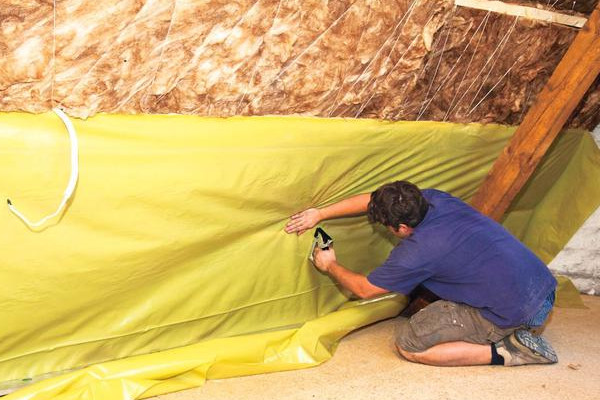
WHERE DO I PUT THE VAPOUR CONTROL LAYER?
Vapour Control Layer usually goes behind or below the insulation in order to keep any nearby moisture at a manageable level. So when insulation is introduced between rafters it goes over the rafters. In the case of a suspended floor, the vapour control layer should be laid between the insulation and the floor boards. When it comes to concrete floors, vapour permeable membrane usually sits between PIR insulation and screed to prevent a reaction between the wet screed and the foil facer board where small volumes of gases given off can weaken the screed. We present most of them below.
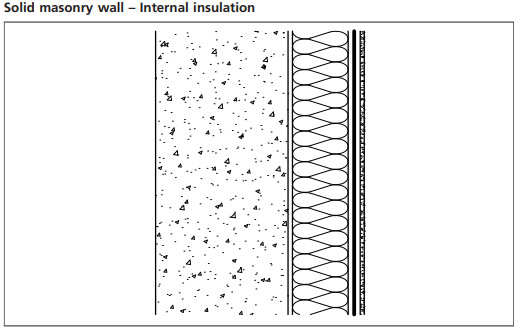
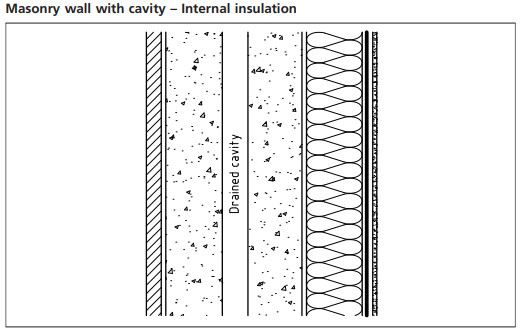

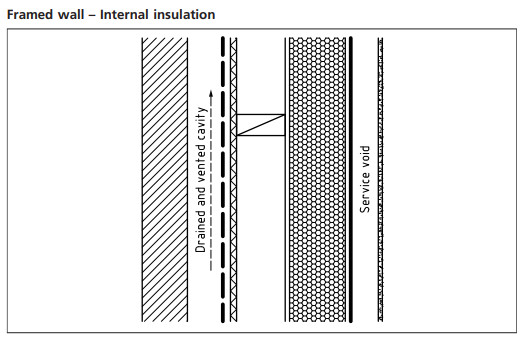
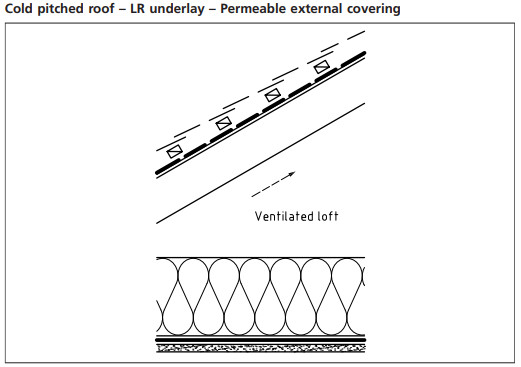
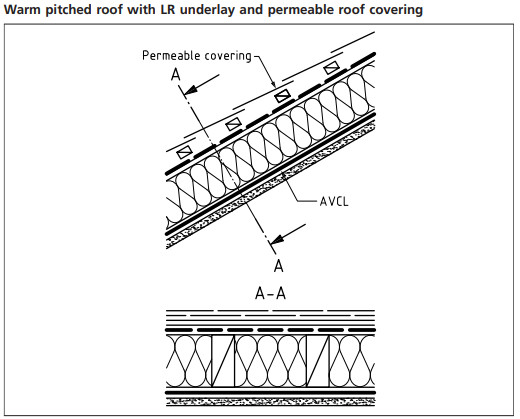
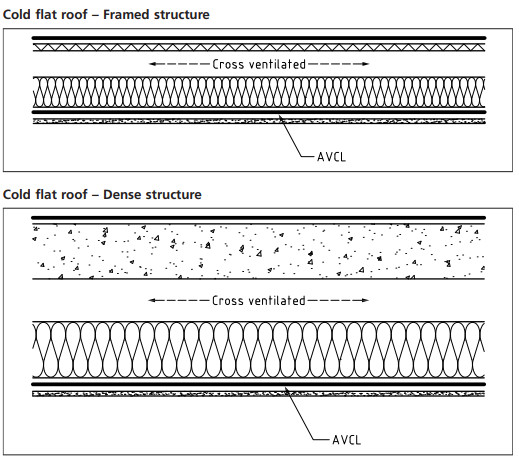
Pictures credit:bsigroup.com
WHEN DO I NEED A VAPOUR CONTROL LAYER?
UK buildings with poor ventilation systems are especially vulnerable to moisture. It gets even worse when there is a lack of sufficient insulation and the amount of steam produced cannot be reduced.
Steam is formed during many household activities, e.g. bathing, washing dishes or cooking. This is why water vapour circulates around the house. In the case of an efficient ventilation system (such as mechanical ventilation), it is effectively discharged. In another situation, it simply penetrates deep into the structure of the building such as rafters or insulation.
Settling water vapour reduces the life of insulation. This means that it will be destroyed much faster than it should.
Installing a vapour barrier layer makes it possible to comprehensively protect the rafters or insulation against damage. It is also good to know that the foil does not adversely affect the properties of the insulation. It is only a protective layer, but in no way affects the deterioration or improvement of the parameters of the insulation layer. So to sum all up - if your ventilation is poor, most likely you will need a vapour control layer. There is no need to install the VCL if the house has efficient mechanical ventilation.
VAPOUR CONTROL LAYER SD VALUE. WHY IS IT SO IMPORTANT?
The type of VCL foil must be carefully matched to the place where it will be located. A poorly selected one will not only not fulfil its task, but will also have a negative impact on the insulation of the building. When choosing a vapour membrane, you should also pay attention to its technical parameters. Of great importance is the so-called Sd factor, which determines the level of vapour permeability.
WHAT IS Sd VALUE?
Sd value is a measure of breathability as it measures a material's resistance to the transmission of water vapour through it. The Sd value refers to the resistance shown by the equivalent thickness of air, so the lower the number the better the breathability. The higher the Sd-value, the higher the moisture resistance during winter conditions and the lower the drying out potential during summer weather.
The value of this parameter depends on the type of foil used. Knowing the vapour control layer Sd value allows you to select the right membrane for the right application. The Sd value should be listed in the product datasheet provided by the manufacturer.
HOW TO UNDERSTAND THE Sd VALUE?
In simple terms, it determines the effectiveness of the protective layer. For example - Sd at the level of 50 metres makes the film a barrier for water vapour as 50 metres of air.
It might seem that it is safest to reach for a VCL with the highest Sd factor. This may surprise you because in reality it works the other way round. The higher the value the less moisture will penetrate from the room side towards the insulation. The lower the number, the quicker the VCL membrane lets water vapour disperse.
For instance, aluminium VCL foils are considered the tightest. Here, the Sd factor is usually greater than 100 metres.
The reinforced VCL Sd factor is quite high too. It ranges from several dozen to 100 meters. In fact, materials with an Sd-value greater than or equal to 100m are considered to be vapour barriers.
On other hand, Polyethylene VCL’s are typically offered with Sd-values ranging from >20m up to 100m. The broader the Sd-value range of a variable VCL, the higher the humidity protection.
Traditional, high resistance VCLs can prevent drying out in any direction, other than to the outside, whereas a low resistance VCL could allow too much vapour to pass into the structure.
If you are still unsure what VCL you should use, consider intelligent VLC foil. This is a real game changer. It ensures optimum moisture flow through building structures with a Sd range of 0.4m to 60m. This high-performance intelligent vapour control layer adapts its vapour resistance to the environment. Thanks to its unique design, the membrane offers variable permeability that adapts to changes in humidity levels and allows the structure to dry out in the summer and sunny days in spring and autumn while protecting it from moisture overload in the winter and cold, wet days.
WHAT WILL HAPPEN IF I CHOOSE WRONG VAPOUR CONTROL LAYER?
Having the wrong VCL installed will either allow too much moisture to permeate into the insulation and fabric of the building, which in the long term can cause the insulation to degrade and the structure to corrode.
TYPES OF VAPOUR CONTROL LAYER ǀ MATERIAL
Vapour control layer (VCL) is made of several different materials. Each type of foil has completely different properties. Materials like polyethylene have very low permeability ratings, meaning they are the most effective.
There are a number of different types of VCL’s available, depending on the requirements of the project being undertaken. They can be in the form of a polythene membrane, foil backed plasterboard or foil backed insulation.
Typically vapour barriers have a very low permeability, but are not completely airtight. Where they are airtight, they may be described as air and vapour control layers (AVCLs).
POLYETHYLENE VAPOUR CONTROL LAYER
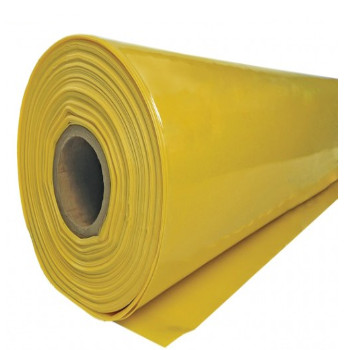 The polyethylene vapour barrier foil consists of only one layer. This is a solution considered classic, which effectively inhibits the penetration of water vapour. Polyethylene (PE) vapour barrier foil most often comes white, green or yellow.
The polyethylene vapour barrier foil consists of only one layer. This is a solution considered classic, which effectively inhibits the penetration of water vapour. Polyethylene (PE) vapour barrier foil most often comes white, green or yellow.
A major issue with unreinforced vapour barriers is their tendency to puncture if snagged on a corner or a screw/nail during installation. As a single layer membrane, there is nothing to stop this small tear from ripping along the whole membrane leaving a gaping hole where moisture and air can move freely causing untold damage to the fabric of the building and reducing the energy efficiency of the system.
REINFORCED POLYETHYLENE VAPOUR CONTROL LAYER
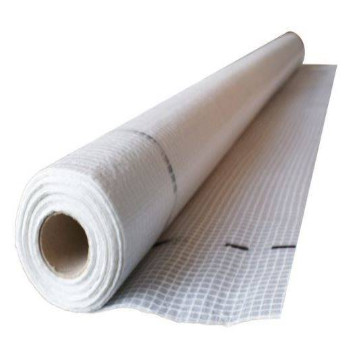 Reinforced vapour control foil usually comes white and is reinforced with additional reinforcement, which is made of polypropylene mesh. Unlike unreinforced VCL, reinforced vapour membranes are manufactured by laminating two layers of thinner membrane with a core of reinforcement mesh, normally multifilament PE.
Reinforced vapour control foil usually comes white and is reinforced with additional reinforcement, which is made of polypropylene mesh. Unlike unreinforced VCL, reinforced vapour membranes are manufactured by laminating two layers of thinner membrane with a core of reinforcement mesh, normally multifilament PE.
Reinforced vapour control layer is a very strong, tough and durable, polyethylene-based vapour control membrane with a mono-filament reinforcement scrim for tensile strength in wall and roof installations for use within roof and wall constructions to prevent warm, moist air entering the building fabric and condensing within the insulation.
Reinforced vapour control layer can be utilised where very high moisture vapour resistance is not a necessity but a strong, durable airtight membrane is. Therefore, the better the building is ventilated, the faster we can use such a film. The woven, polypropylene, multifilament scrim reinforcement provides good resistance to tears and punctures. The reinforcement grid gives great strength and tear resistance, producing membranes which are robust and easy to install. While roll length is usually 50m or 100m long, widths may vary ranging from 1.5m, 1.6m, 2m to 3m.
The higher the roll tensile strength is, the tougher the material is. The current highest tensile strength achieved by manufacturers is 5.8 kN/m. Rolls come in 4 main colours:
- White (Novia SRTP and Visqueen),
- Translucent (Proctor Procheck),
- Silver (YBS Foil-Tec VCL).
The Sd factor of reinforced foil is quite high. It ranges from several dozen to 100 meters.
ALUMINIUM FACED VAPOUR CONTROL LAYER
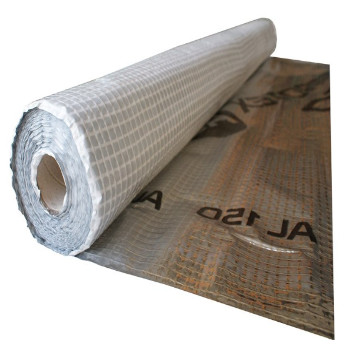 Aluminium foil membrane is a three-layer aluminium foil which is used extensively in both new-build constructions and renovations. The upper and lower layers are made of aluminium polyethylene film and the inner part is reinforced with PP network to ensure an extremely high tensile strength. The top layer of polyethylene is metallized with the heat-reflective surface of aluminium. It is a great option, due to its durability, waterproof barrier and non corrosive upper and lower layers.
Aluminium foil membrane is a three-layer aluminium foil which is used extensively in both new-build constructions and renovations. The upper and lower layers are made of aluminium polyethylene film and the inner part is reinforced with PP network to ensure an extremely high tensile strength. The top layer of polyethylene is metallized with the heat-reflective surface of aluminium. It is a great option, due to its durability, waterproof barrier and non corrosive upper and lower layers.
Moreover, it offers radiant heat-resistance by up to 97%, stability and tear-resistance.The product is widely used in the construction of floors, between ceiling joists and under plasterboard.
OSB AS A VAPOUR CONTROL MEMBRANE?
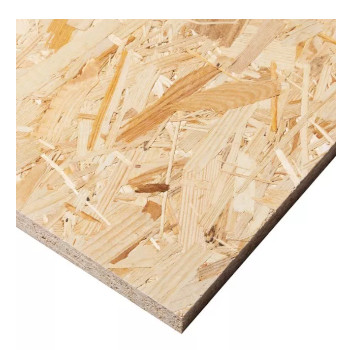 Vapour control can be performed very accurately by the many membranes available but it can also be performed at a basic level by OSB, whose vapour resistance (or vapour permeability) is similar to that of some membranes.
Vapour control can be performed very accurately by the many membranes available but it can also be performed at a basic level by OSB, whose vapour resistance (or vapour permeability) is similar to that of some membranes.
The benefit of using OSB as a VCL is that it is far more robust than a 0.2mm membrane and does not require the installation of another layer into your timber frame structure if used internally.
FOIL FACED INSULATION AS A VAPOUR CONTROL LAYER?
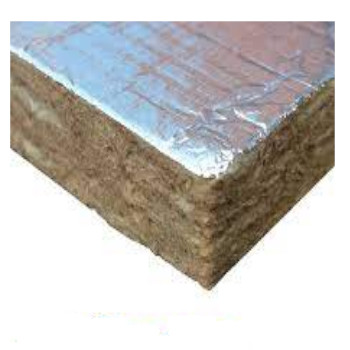 Generally speaking, all foil-faced insulation such as Rockwool RW or Knauf RS range may be used as a VCL provided all joints are properly taped with a suitable foil tape. Foil faced insulation is typically used in first-time applications, such as in walls, ceilings and floors.
Generally speaking, all foil-faced insulation such as Rockwool RW or Knauf RS range may be used as a VCL provided all joints are properly taped with a suitable foil tape. Foil faced insulation is typically used in first-time applications, such as in walls, ceilings and floors.
Any time you use a faced insulation, the foil needs to be facing toward the living space. So in a loft the foil faces downward.
PIR Celotex PL4000 features a vapour control layer built in. It is positioned between the plasterboard and Celotex foam insulation.
When the boards are tightly butted together, the tapered edges of the plasterboard are sealed with scrim tape and jointing compound to form an effective vapour control layer with a high vapour resistance.
INSULATED PLASTERBOARD AS A VAPOUR CONTROL MEMBRANE?
Products such as insulated plasterboard or foil backed plasterboard tend to act as a vapour barrier. Really? No, they only work as a vapour control layer if none of the joints or penetrations are sealed. Therefore, these products should not be used instead of a VCL. However, the VCL may take the form of a vapour control plasterboard when used subject to a condensation risk analysis demonstrating the suitability of the wall build up. It should also not be used if there are service voids proposed or electrical or other wall mounted fittings where there is a high risk that follow-on trades could puncture the VCL and allow paths for water vapour to get into the wall construction.
INTELLIGENT VAPOUR CONTROL LAYER ǀ WHAT IS SO SPECIAL ABOUT IT?
 In the UK, Autumn and Winter are often typical for being wet, windy and cold, whilst spring and summer can often be sunny. These distinctive seasonal changes can have a considerable influence on the moisture migration in roof construction. A vapour barrier with a moderate Sd-value would be a great idea in this situation.
In the UK, Autumn and Winter are often typical for being wet, windy and cold, whilst spring and summer can often be sunny. These distinctive seasonal changes can have a considerable influence on the moisture migration in roof construction. A vapour barrier with a moderate Sd-value would be a great idea in this situation.
This is where an intelligent vapour control layer takes its place.
Intelligent vapour layer such as Proclima's Intello Plus or Vara Plus membrane is a smart, new generation advanced building material that has been created to provide variable permeability which means it can adapt to changes in humidity conditions.
In fact, intelligent VCLs change their permeability, becoming more vapour resistant during winter and more vapour permeable in the summer.
It allows vapour to diffuse through it when humidity is high within structural elements, either due to seasonal change or unexpected moisture intrusion. When the average humidity is low (winter condition), the membrane resists the penetration of vapour into structural elements, preventing condensation. If the average humidity at the membrane is high (summer conditions), the membrane's vapour resistance decreases substantially.
VAPOUR CONTROL LAYER PRICE
Generally speaking, VCL foils are quite inexpensive to buy. Vapour control layer membrane is typically priced by square metre, with rolls available in standard 50 metre lengths. At 1 metre wide, this equals 50 square metres of membrane. Some manufacturers also provide a second width of 1.5 metres, which gives a total of 75 metres squared.
If you do need to install your VCL membrane, it can cost anywhere between £97.96 per standard polyethylene roll. VCL prices vary widely depending on their properties and might range from as little as £0.72 per square metre (Novia 500G Vapour Control Layer) right up to £2.30 per square metre for more specialist products (Novia STRP Reinforced Vapour Control Layer).
Generally speaking, you will pay about £1-1.5 per m2 for a classic (polyethylene) foil. It is the cheapest possible variant. You will pay a bit more for aluminium vapour foil - its price is on average £3-5 per m2.
Please note, vapour control barrier installation services are not cheap. On top of material cost, you will also pay about £5-6 per m2 for professional installation.
VAPOUR CONTROL LAYER INSTALLATION
Anything used as the vapour check layer needs to be continuous. Special attention is required when sealing the overlaps between the strips. If the finish is not carried out well enough, the vapour control layer won’t be effective at all. Therefore, for framed structures such as timber frame and steel frame systems, a VCL should be used on or near the warm side of the insulation. The vapour control layer must not be fitted until the studwork moisture content has dropped below 20%.
When fitting a VCL, you need to ensure that you don’t puncture the layer itself. You can use screws to fix your VCL to timber so long as they go through the joists and not the actual layer. Using staples to fix your VCL follows the same principles as using screws. After the VCL has been screwed, the edges may still need to be taped appropriately.
Duct tape is not an appropriate substitute for vapour tape and should not be used when fixing a VCL!!
Vapour Control Layers are usually sealed with one of our double-sided butyl tapes using, following criteria:
- Minimum 150 mm for vertical
- Minimum 100 mm lap for horizontal
- Laps are to be taped with a minimum width of 50 mm.
Joints in vapour control membranes should be located on studs or noggins. Any pipes or electrical fittings which pass through the vapour control layer should be kept to a minimum and taped. Particular care must be taken around openings such as ceiling hatches and service penetrations such as cables, ducts, sockets, light fittings, and so on.
The vapour control layer must be dressed in door frames, heads or window sills and extended a minimum of 75 mm into the ceiling to gain an effective seal.
Small tears can be repaired. However, where large damage is inflicted it is recommended that the sheet be removed and replaced and the laps be resealed again. It is wise to inspect the vapour control layer after installation.
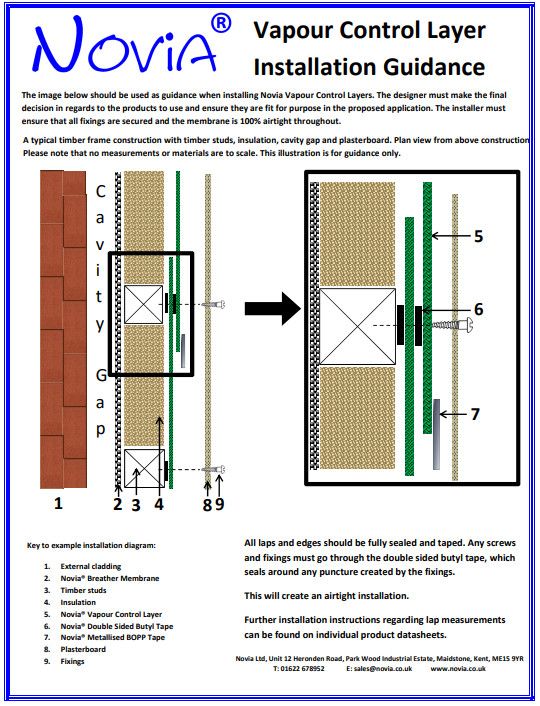
Picture credit:novia.co.uk
VAPOUR CONTROL LAYER ON THE WALLS
In most new build timber frame wall constructions, a VCL is a requirement according to Building Regulations. During the winter months when condensation tends to occur, driving rain may also enter the fabric of the building, further increasing moisture levels in walls. Therefore it is very important to prevent this condensation process occurring in the first place, for the longevity of the building.
In the summer months, the higher temperature is found on the outside of the wall and the lower temperature on the inside. This creates a situation where moisture is driven inwards and condensation can form close to the inner face of the wall instead.
The answer to keeping timber-framed walls dry is to use a layer to restrict the flow of moisture but not to try and stop it.
VAPOUR CONTROL LAYER ON THE FLOOR?
The purpose of the vapour control layer between the insulation and concrete is to prevent the concrete seeping into any gaps between the boards. When PIR insulation such as Celotex is used on the floor, VCL foil should be laid to stop the aluminium PIR face reacting with the concrete.
In fact, VCL polythene membrane on top of insulation below a screed or concrete oversight performs three tasks:
- it acts as a vapour control layer (VCL);
- it prevents migration of the screed which can force the boards apart leaving cold spots in the floor;
- it prevents a reaction between the wet screed / concrete and the foil facer where small volumes of gases given off can weaken the screed/concrete.
Where the DPM is on the cold side of the insulation, a separate VCL should be placed on the warm side of any thermal insulation. Given the small additional cost of some additional polythene then it's not worth not doing it surely.
CELOTEX UNDER SLAB INSTALLATION GUIDELINES
• Level hardcore and blind with sand
• Install damp proof membrane and lap into damp proof course
• Use the Celotex Insulation Saw to cut and fit insulation, thickness to achieve required U-value
• Use the Celotex Insulation Saw to cut and fit insulation upstand to floor perimeter, to meet a minimum R-value of 0. 75m²K/W, (i.e. Celotex TB3020). Height of insulation to coincide with required finished floor level.
• Lay a polythene vapour control layer (VCL) over the insulation to minimise the risk of condensation forming at insulation/slab interface.
• Lay concrete to required finished floor level and smooth over with float finish.
VAPOUR CONTROL LAYER THICKNESS
The thickness of VCLs ranges from a simple single layer polythene VCL at 500 gauge, which is 125 microns or 0.125mm thick. VCL can also be found in 0,20, 0,25 and 0,40 thicknesses. Reinforced VCL comes in certain thicknesses such as 0.15mm, 0.29mm, 0.31mm, 0.37mm, 0.4mm or 0.5mm. All rolls come in multiple roll sizes such as 4m x 25m, 1.5m x 50m, 1.6m x 50m and 2.7m x 50m.
All vapour control materials should come with an approval certificate or under EN13788 must be specified by condensation risk analysis. The NCC requires a vapour barrier be a nominal 0.2mm thick or 200 µm, which is the thickness in microns.
To sum all up, vapour barriers should be at least 0.2mm in thickness to effectively create a moisture barrier.
VAPOUR CONTROL LAYER TAPE
Vapour control layers are always required whenever you insulate your home. This is a fact, they should be always used to form a continuous airtight layer and so all the joints must be sealed with the appropriate airtightness tapes. Without good levels of airtightness the VCL does not work and moisture levels cannot be controlled inside the structures. Therefore, always make sure that your VCL is sealed with the appropriate tapes such as Novia Seam or Visqueen tape.
VAPOUR CONTROL LAYER BUILDING REGULATIONS
Approved Document C of the Building Regulations say in effect ‘you must design and construct buildings so that the structure of the building and the health of the occupants is not affected by moisture; to do this, follow the guidance in BS5250’.
Vapour control materials are regulated by BS 5250 code. In fact, BS 5250 has been an essential reference of that part of the Building Regulation that covers moisture issues, in all the four parts of the UK for almost 20 years. It details best practices for ensuring a code of practice for preventing moisture in buildings to minimise risk to the users. It also provides building designers with guidance on safeguarding the health of occupants by considering likely sources of moisture, avoiding the build up of excessive moisture, and preventing mould growth and condensation. It describes the principal sources of moisture in buildings, its transportation and deposition and provides recommendations and guidance on how to manage those risks during the assessment, design, construction, and operation of buildings.
For more information click here
Related articles:
MINERAL WOOL INSULATION. THE UGLY TRUTH?
BUILDING REGULATION PART L CHANGES
HOW TO PREVENT WINDOW CONDENSATION
*All the information provided in the content published on Insulationgo blog is for informational and educational purposes only. Insulationgo LTD makes every effort to ensure the accuracy and timeliness of the content, but we do not assume any responsibility for any errors or omissions.
The information presented on this blog should not be considered as professional advice or a substitute for consulting relevant experts. Before making any purchase decisions or taking action based on the information presented here, it is strongly recommended to contact the product manufacturer directly to verify the details and ensure its suitability for your specific needs.
By using this blog, you acknowledge and agree that Insulationgo LTD shall not be held liable for any damages, losses, or inconveniences arising from the use or reliance on the information provided herein. This limitation of liability applies to all users of the blog, including but not limited to visitors, readers, and subscribers.










































































































